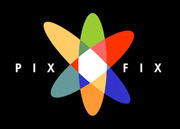|
This "Oddly
Bizarre" Process
by Bob Staake
To say that
I didn't know a thing about computers in 1995 would the understatement
of the century -- both the 20th and the 21st.
I was fortunate
enough to build a solid career as a humorous illustrator with
a decidedly "cartoonish" style, a visual approach that
many reviewers would categorize as "retro" or "1950s
modern", as if Hanna-Barbera, UPA and early MAD magazine
were thrown into a blender and switched to 'frappe'.
It was a style
that saw me working for some of the top clients in the nation,
an ecclectic mix consisting of every forum from The Washington
Post to TIME, Cartoon Network to Hallmark Cards, Ralston
Purina to the Children's Television Workshop -- and yes, even
MAD.
My process
then was simple, one detailed in HOW magazine and Step-by-Step
photo spreads; I'd pass on a pencil and draw my line art in pen,
paste those drawings to a board, Xerox it onto drawing paper,
then paint the art in watercolor, gouache and prismacolor pencils.
It was a process more grounded in reality -- the need to crunch
out a lot of work for reproduction, and no time to be
a purist about how the original art might look framed on a wall.
I was comfortable
working this way and found I could almost create those images
in my sleep. You'd see my overly-colored drawings on cereal boxes,
screaming from greeting cards, animated on tv programs, imprinted
on almost any surface that could be imprinted.
I had no intentions
whatsoever of goofing around with a good thing -- until 1994.
I was writing a book for North Light called The Complete Book
of Humorous Art, and in the process of interviewing twenty
other colleagues about their work methods, their approach to
their art, their take on the future of the profession, I was
amazed at how many of them were creating their images on a computer
-- or at least claimed to be.
Learning this,
of course, fully plunged me into panic mode. How would I be able
to "compete" in the mercurial world of commercial illustration
if I wasn't creating my art digitally like everyone else? How
could I be expected to keep getting assignments when I'd have
to FedEx them to a client when my colleagues could "email"
their art to editors instantaneously? At the relatively
young age of 38, I saw my future as an illustrator from blackened
sunglasses as I was sucked deep into the tar pits to join the
rest of the dinosaurs who didn't have a clue what a 'mouse' was,
who didn't understand what 'dpi' meant.
It was a rude
wakeup call to be sure, but then I recalled what a newswriting
professor of mine at USC told me in 1979. "Staake",
he deadpanned, "the day will come when you'll send your
drawings to editors over a phone line", and apparently,
that day was now.
I called an
art director friend at Ralston Purina to ask him how specifically
I could make the transition from paint to pixels. I explained
to him that I didn't want to kill the goose that was laying all
those golden illustration eggs week in and week out, "I
just want to be able to draw my art with a pen, digitize it,
and then I guess apply color".
"Hmmmm",
he said. "Well, you can do that in Photoshop."
 Photoshop. I'd heard the word
before. It was a "program", I thought, but I wasn't
sure if it was hardware or software. The bottom
line was that you'd put this Photoshop into your computer, you'd
hook up this thing called a scanner, and then you would be able
to use these digital "tools" to color the artwork. Photoshop. I'd heard the word
before. It was a "program", I thought, but I wasn't
sure if it was hardware or software. The bottom
line was that you'd put this Photoshop into your computer, you'd
hook up this thing called a scanner, and then you would be able
to use these digital "tools" to color the artwork.
It was obvious
-- I needed to buy a computer and start creating art in Photoshop.
I bought a Mac Power PC 7100 (with a whopping 500 mb hard drive!),
a Umax scanner (I think that set me back $1200), monitor that
weighed slightly more than a medium-sized barnyard animal, a
Laser printer, an external Syquest drive, and Adobe Photoshop
3.0.
I was April
of 1995 and I was ready to go -- I just needed somebody to give
me a shove. That's how I learned to swim as a child after all.
In the middle of the Salton Sea in Southern California, dad threw
me off our boat. I splashed, I panicked, I inhaled saline water
-- but I apparently swam, or at the very least was able to tread
water. It was a traumatic experience, but it's amazing how many
times I'd call on the not-so-hidden message behind the event;
find a way to swim or you'll die.
The computer
was set up, all spanking new, the drab Apple beige harkening
more to the company's Mac Classic period of the 1980's than its
candy-colored iMac comeback in 1999. I left for a quick two week
vacation in Europe with my family and vowed that when we returned
and as soon as the phone rang with an assignment, I would find
a way to do it digitally on the Mac. No brushes slathering paint,
no Prismacolors grinding in any of 200+ shades, no more waffling
on the fence.
After we returned
to the states, the phone rang. It was an art director at the
Chicago Tribune asking me if I could do a spot illustration.
I roughed up some sketches, faxed them to her, and when she selected
one, I drew it up in my usual fashion -- as line art created
by using a black Fountain Pentel. Ready for coloring, I lifted
the lid of the Xerox machine out of habit, but instead of reproducing
the line art on a pristine piece of drawing paper on which I
would typically apply color, I stuffed the drawing into the scanner,
opened Adobe Photoshop 3.0, used the pulldown menu to go to File,
then Acquire, and finally selected UMAX scanner.
A bright flourescent
light leaked out of the heat ventilator holes on the scanner.
I heard the sounds of gears turning and motors buzzing - then
silence. The scanner hummed and recoiled to be ready to scan
antyhing else I'd ask it to and as it did, my black and white
lineart appeared on the screen!
What I didn't
realize then was that when my art director friend had suggested
that I could scan my art using Photoshop, one would traditionally
do so to gain a digital image of their art, but then open it
in another program (Illustrator, Painter or Freehand) to add
color. Since I knew absolutely nothing about computers let along
digital imaging software, I simply plowed ahead in Photoshop.
I discovered that if I clicked on an icon that looked like a
paint bucket it would dump the color of my choice on the art.
If I used a tool that looked sort of like a magic wand that I
could highlight areas in which to add a variety of digital effects.
But by far
the most amazing thing I discovered was how I could change the
properties of a paint brush from 'normal' to 'dissolve' -- and
it is the discovery of that very simple little effect that wholly
revolutionized my illustration.
By forcing
the paintbrush to apply pigment in a dissolve mode, I could create
the illusion of shading -- but when deconstructed, the "shading"
was nothing more than the result of similarly colored pixels
being "spattered". The effect was amazingly similar
to working a dry toothbrush into paint of the correct consistency
and then rubbing your thumb across the bristles so pigment could
be coarsely spattered.
Stumbling on
the ability to achieve a spatter-cum-dissolve effect digitally
was mind blowing to me for two reasons; first, it looked amazingly
similar to the "toothbrush" shading effects the Europeans
employed on posters of the mid-20th Century and secondly, discovering
how to create such an "organic" effect in computer
software perceived by many (artists included) to be cold, detached
and almost anti-artist enabled me to appreciate Photoshop not
as some sort of malevolent technological new tool, but a program
that could be used in wildly creative ways -- perhaps ways that
the designers of the program never even imagined it could be
used.
At the same
time that I was using Adobe Photoshop 3.0 to scan and color my
traditional "cartoonish" illustration art, I was also
utilizing the tools alone to create shapes, forms and visual
effects. Using nothing but a mouse to in Photoshop always felt
a little like I was "drawing with a bar of soap", but
it wasn't difficult getting used to the process (I've never even
tried using a Wacom tablet).
 By 1998, I was working
in two distinct (yet connected) visual styles that I found both
the need and the desire to promote each via my web site. The
problem, though, was not knowing how to distinguish each in the
minds of the art directors I was already working with, and those
who wanted to work with me. For lack of better terms, I called
my more "cartoonish" line art-based digital work 'Normal
Bob', my more "designier" work reminiscent of European
poster artists of the Mid-20th century as 'Digital Bob'. By 1998, I was working
in two distinct (yet connected) visual styles that I found both
the need and the desire to promote each via my web site. The
problem, though, was not knowing how to distinguish each in the
minds of the art directors I was already working with, and those
who wanted to work with me. For lack of better terms, I called
my more "cartoonish" line art-based digital work 'Normal
Bob', my more "designier" work reminiscent of European
poster artists of the Mid-20th century as 'Digital Bob'.
Today, I continue
doing cartoonish "Normal Bob" work for certain clients
(a weekly piece in The Washington Post, illustrations
for MAD, character design for Cartoon Network, etc), but
my transition into the 100% "Digital Bob" world has
been so rewarding that were I never to physically get gesso under
my fingertips, that wouldn't worry me in the least.
Ah, but Adobe
Photoshop 3.0...
I continue
to work in the program even although I have Adobe Creative Suite
2 on my G5. For me, the familiarity of Photoshop 3.0 keeps me
locked into the program, even though my son says the days are
officially numbered given that the classic program won't physically
run on the new dual processor Macs (and being an Apple employee,
he should know).
Well, all great
relationships have to come to and end, I guess -- one way or
another.
Then again,
I suppose I could always find a good, used single processor
G5 being sold on ebay, right?
-
- - Bob Staake
- Chatham, Massachusetts
- December 30,
2007
|



